
Chiang Rai is located in northern Thailand.
Historically, it has been famous for the production of opium. Nowadays, Chiang Rai is described as the agricultural centre of Thailand due to its rich countryside and abundance of orchards and tea plantations. It is set in the mountains of Thailand, and the landscapes to be found here are picturesque.
It is also part of the famous Golden Triangle, the area where the borders of Thailand, Myanmar, and Laos meet. Additionally, the Golden Triangle is where the River Kok meets Mekong River (Mae Khong River).
Read on to learn more about Thailand’s fascinating hidden gem.
Just a few hours north of Chiang Mai in northern Thailand, Chiang Rai is high above sea level. Jungles, grassy plains, and rivers help keep Chiang Rai province cooler than some other parts of the country.
Chiang Rai city is one of the smaller cities in northern Thailand. However, it still boasts many tourist attractions, such as the Chiang Rai Night Bazaar, where travellers can experience authentic Thai food- such as the famous Khao Soi.
Chiang Rai also contains what is widely considered the most sacred Buddhist temple in Thailand, Wat Phra Kaew. It was here that the Emerald Buddha was found in 1434, and the Emerald Buddha is still the most revered Buddha image in history.
June to October is monsoon season throughout all of Thailand. In Chiang Rai, days are shorter during the rainy season, and rain generally falls the most in August and September.
However, while this season is the wettest, rain typically occurs in bursts of warm showers during the afternoon, which means that the mornings and evenings are still open for activities. Nevertheless, the high humidity might still be unpleasant, and many travellers opt for indoor activities during this time.
One popular tourist destination tourists enjoy visiting when the weather is too muggy is the Baan Dam Museum, often referred to as the Black House, an exciting mixture of traditional architecture, art, and modern design.
Another plus-side of visiting Chiang Rai province during the off-season is that flights and accommodation will cost less than during peak tourist season.
The hottest season in Chiang Rai weather spans from March until May. The average temperature during the day can climb as high as 105 degrees Fahrenheit, and it rarely rains during this time.
The intense heat makes this season unpleasant for travellers who enjoy outdoor activities like sightseeing or hiking. Some seasoned travellers even advise wearing long sleeves while out and about to protect against the sun.
However, while perhaps not ideal for visiting cultural tourist attractions, many people who visit Chiang Rai during this season enjoy going to the hot springs, waterfalls, or Kok River to cool off. Accommodation and flight prices are also slightly lower in this season.
November to February is Chiang Rai’s coolest season. Humidity is pretty low during this time as it rains very rarely, making this the ideal time to visit Chiang Rai. Skies are clear blue, and the weather is refreshing.
In this season, average temperatures are around 75 degrees Fahrenheit during the day. Nighttime temperatures can drop to about 50 degrees. The pleasant weather makes this the ideal time to travel to Chiang Rai, go sightseeing, or visit temples.
Much like the neighbouring Chiang Mai, Chiang Rai has many cultural and historical sites for tourists to visit. One of the most famous temples in Chiang Rai is Wat Rong Khun, dubbed the White Temple for its unique and striking appearance.
Other attractions that visitors enjoy are Wat Rong Seur Ten, also called the Blue Temple, the Hill Tribe Museum, and the Oub Kham Museum.
However, do note that January and February are the busiest months to visit Chiang Rai, and the area will be filled with tourists. Furthermore, because this is peak season, flights and accommodation are most expensive during the cool season.
November to February is the best time to visit Chiang Rai, weather-wise. Days are cool and pleasant, making it ideal for any outdoor activities or excursions to truly immerse yourself in Thai culture. There are also many festivals and events to enjoy this time of year.
However, this is peak season. As a result, Chiang Rai will be filled with tourists, and prices will be higher.
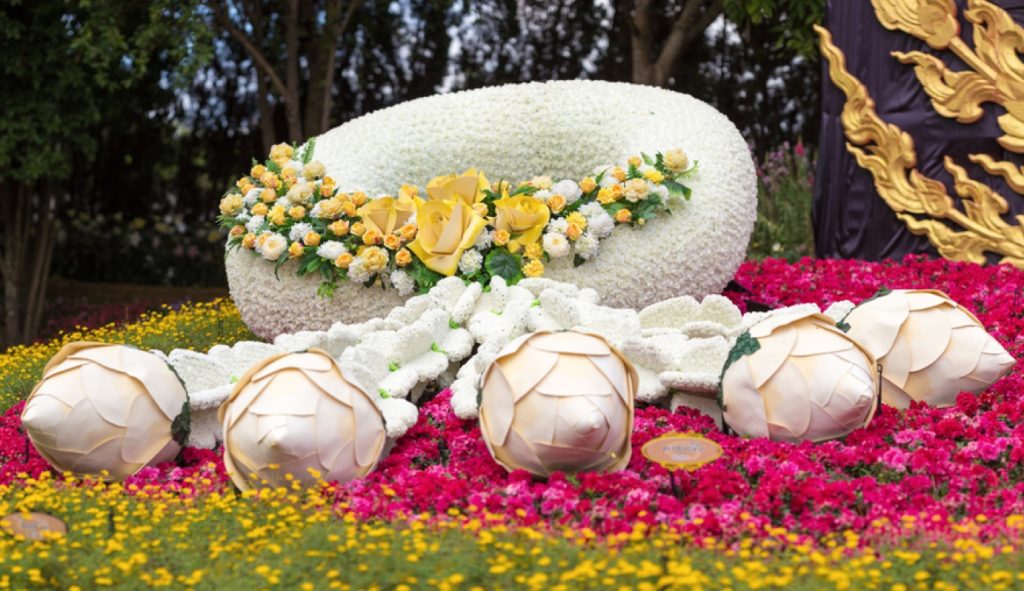
Key events:
Chiang Rai Flower Festival – Held annually in late December and early January, hundreds of beautiful flowers are displayed to promote tourism (similar to the Chiang Mai Flower Festival).
Dok Sieo Festival – Celebrated around Valentine’s Day, people gather at Phu Chi Fah to witness the beautiful pink and white blossoms on the trees and enjoy performances by residents of the hill tribe villages.
Akha Hill Tribe Performance – Every month, the Akha hill tribe hosts a performance to celebrate the life and culture of their tribe, which costs about 165 Thai Baht.
Both the warm and rainy seasons in Chiang Rai are not ideal for tourists. These months bring immense heat and excessive humidity, making outdoor activities unpleasant.
However, while the weather may not be the best during this time, there are still many festivals to enjoy in Chiang Rai, and prices are lower than in peak tourist seasons.

Key events:
Chiang Rai Lychee Festival – Held each year in May to celebrate the lychees Chiang Rai is most famous for and includes the popular Miss Lychee Orchard contest and Papaya Salad competition.
Songkran – Thai New Year that is celebrated in April, locals and tourists cool off in the streets with watersports.
Pang Sida Butterfly Watching Festival – Held each year in May and July at the Pang Sida National Park when hundreds of butterflies gather for tourists to see.
Chiang Rai, Thailand, is a relatively small city compared to the neighbouring Chiang Mai, or Bangkok, Thailand’s capital. It has a population of around 69 thousand people, making it almost half the size of Chiang Mai.
Chiang Rai is part of the Golden Triangle, the place where the borders of Thailand, Myanmar and Laos meet in the Chiang Rai province.
There are various reasons to explore Chiang Rai. Some of the most popular tourist attractions in Chiang Rai are the many unique temples. Chiang Rai is home to the iconic Wat Rong Khun temple, also called the White Temple for its characteristic white colour, the revered Wat Phra Kaew Buddhist temple, which originally housed the Emerald Buddha, and Wat Rong Suea Ten or Blue Temple.
Another popular destination is Chiang Rai’s Clock Tower. The beautiful Golden Clock Tower is in the city centre, on top of a traffic circle, and shines brilliantly in the sunlight.
Some people visit Chiang Rai solely for the street food, often served at the Chiang Rai Night Bazaar or a food court. Thai food is widely considered one of the most delicious cuisines, and Thailand is especially famous for dishes such as Khao Soi and northern Thai sausage.
Mae Fah Luang is Chiang Rai’s International Airport (CEI). It is situated around eight kilometres from Chiang Rai city centre. Most of Thailand’s domestic airlines operate here, including Thai Airways, Bangkok Airways, Nok Air, Thai Lion Air, AirAsia, and Thai Vietjet Air. There are also some international airlines, such as China Eastern Airlines.

If you are departing from China, there is a direct flight from Changsha to Chiang Rai, which you may take. Other than that, the only direct flights to Chiang Rai are from different areas of Thailand. Travellers from further away may need to take connecting flights.
The most popular options for getting to Chiang Rai are from other cities, like Bangkok.
Chiang Mai is one of Thailand’s two largest cities. However, it is only around 190 kilometres from Chiang Rai, as both are in northern Thailand. Because Chiang Mai is so close, it is popular for tourists to travel between the two cities on a day trip.
Here are some of the most popular ways to get to Chiang Rai.
Getting to Chiang Rai from Chiang Mai takes just over three hours with a public bus.
The GreenBus Company offers bus rides from bus stations in Chiang Mai to Chiang Rai for around 250 to 350 Thai Baht, making it one of the cheapest ways to travel to Chiang Rai.

However, these bus rides can take up to three and a half hours, and there have been some complaints about smell or quality where older buses were concerned.
VIP Buses are typically the best option. Higher class buses are more likely to have air-conditioning and be well-maintained. Be sure to check which buses are offered by your departure bus station.
Another option to get from Chiang Mai to Chiang Rai is a car rental. Car rental companies are often available at the airport, and the most commonly seen companies are Hertz, Avis, and Budget.
The primary appeal of renting a vehicle is that it is private transportation and needn’t be shared with anyone other than the people you may be travelling with. This also means that you can travel to Chiang Rai at your own pace.
However, this is a more expensive option and can cost you anything from 700 THB to a staggering 5000 THB per day, depending on the rental company and car model.



Bangkok is the largest city in Thailand, with a population of over 10 million people, and is about 790 kilometres from Chiang Rai.
One of the most popular ways to reach Chiang Rai is by plane. Bangkok has two different airports, and tourists typically fly to Bangkok first, then takes another flight to Chiang Rai.

A flight from Bangkok to Chiang Rai takes around an hour and a half, making it a popular way for tourists to get to and visit Chiang Rai. However, keep in mind that ticket prices may vary between airlines, depending on the time of year you visit Chiang Rai.
When flying with boutique airlines such as Bangkok Airways or Thai Airways, you can expect to pay around 3000 to 6500 Thai Baht for your ticket. On the other hand, for a flight with budget airlines, such as Thai AirAsia, you can expect to pay about 970 to 1950 THB for a ticket. Other airlines operating in Bangkok that offer flights to Chiang Rai are Thai Vietjet Air, Thai Lion Air, and Nok Air.
Note: Bangkok has more than one airport, and when travelling to Chiang Rai via Bangkok, you may be required to transfer from one to the other. Make sure you have enough time for your private transfer.
Nakhonchai Air is an excellent bus service that travels between Bangkok and Chiang Rai. The buses are modern, high standard, and reasonably priced. The journey from Bangkok to Chiang Rai via bus is about 750 kilometres, and takes around 12 hours to complete.
Chiang Rai is the northern-most city in Thailand, situated in the northern-Thailand province of the same name. It is a popular day tour destination for people visiting Chiang Mai.
Chiang Rai province lies nestled in the hills and is often referred to as the older sibling of Chiang Mai, another province in northern Thailand. However, because Chiang Mai is one of the biggest cities in Thailand, it is nearly always bustling with tourists. In contrast, Chiang Rai is relatively off-the-radar.
Chiang Rai is a small city, but it still has many tourist attractions despite its small size. For example, most tourists visit the many Buddhist temples when they visit Chiang Rai. These temples include Wat Phra Kaew, Wat Rong Khun, Wat Rong Seur Ten/ Blue Temple, and Wat Huay Pla Kang. There are also some famous museums to add to your Chiang Rai itinerary when you explore the city, such as the Oub Kham Museum and the Baan Dam Museum/ Black House.
Read on to discover ways of getting around Chiang Rai city.
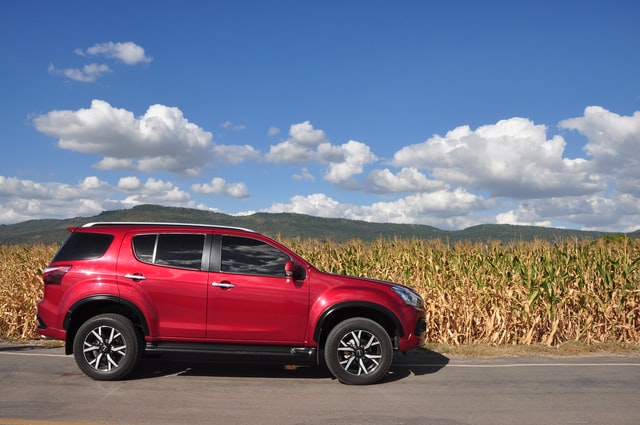
Probably the most recommended method of getting around Chiang Rai, Thailand, is with a private car. The appeal of this is option is its flexibility and comfort. When you use a rental car to get around Chiang Rai, you can decide for yourself where to go and which roads to take.
Cars usually have air-conditioning, which is more comfortable during the hotter months than, for example, a bicycle. A private car also means that you don’t have to share the trip with anyone else, as you may have in a taxi. However, cars are big enough to accommodate groups of people travelling together.
Because it is in the mountainous region of Thailand, many of Chiang Rai’s roads are curved or have sharp turns, which is something that larger modes of transport (like a bus) would struggle with. However, a private car would be more than capable of handling such roads, making it ideal for getting around in Chiang Rai.
Like any big airport, Chiang Rai International Airport offers different car rental services. Avis, Hertz, and Budget are the most common companies available here.
Keep in mind that private car rental services can be more expensive than public transport and could cost you around 700 Thai Baht a day.
Note: A pre-paid taxi or metered taxi is easily found throughout Chiang Rai. However, unless used to get from Chiang Rai International Airport until you reach Chiang Rai city centre, most travellers agree that these are not recommended.

Another great way of getting around Chiang Rai is with a ride-hailing app. These offer the same benefits of renting a car, but with more options regarding which vehicle you use. Ride-hailing apps are also often a cheaper alternative to rental cars.
Grab is a popular app similar to Uber and works throughout Southeast Asia. Because of the many different options, tourists can decide which vehicle suits their needs and budget the best. For example, Grab Taxi works in a similar fashion to other taxis in Chiang Rai, while Grab Premium includes luxury vehicles. It is user-friendly and can be downloaded before you visit Chiang Rai.
Another perk of the Grab app is Grab Food. Travellers can use this to order Thai food and have it delivered. Some of the most popular Thai street food dishes are Pad Thai, northern Thai Sausage, and Khao Soi, and can be found at food stalls in Chiang Rai’s Night Bazaar, Sunday Walking Street, at any night market food court, and through the Grab Food app.
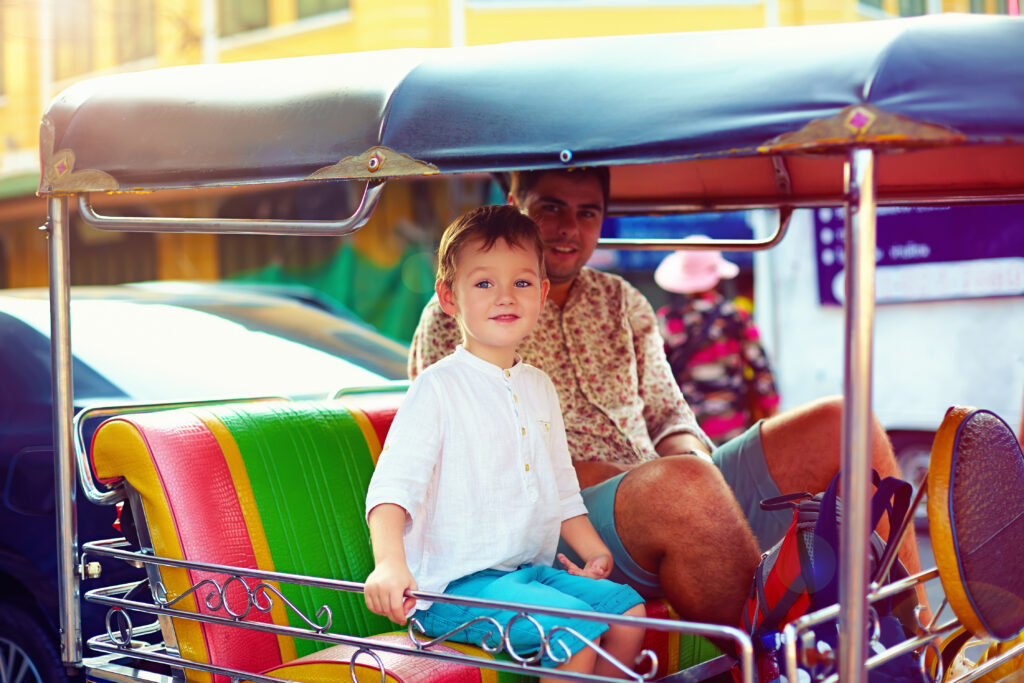
If you are looking for a more traditional form of transportation and travelling by yourself, a tuk-tuk or samlor ride could be your best bet.
Tuk-tuks are three-wheeled taxis that can fit a driver and a single passenger and are often powered by motorcycle engines. They look like little vans without doors and are common throughout Thailand. Usually scattered around popular tourist attractions, airports, Chiang Rai City Centre or even the Chiang Rai bus station. Because Chiang Rai is such a small city, a tuk-tuk could be ideal for getting around. They are also much cheaper than a rental car.
Another great traditional option is samlor. Similar to a tuk-tuk, samlor are three-wheel vehicles that can accommodate one passenger. However, they are bicycle-driven rickshaws, and most of the drivers are older men who have been in this dying trade for decades, which means that they don’t go as fast or as far as a tuk-tuk.
It is common practice to negotiate prices with tuk-tuk or samlor drivers before getting in to ensure that you get the best price for your trip. Depending on how far the ride is and how well you are able to haggle, tuk-tuk and samlor rides can cost from 30 to 500 THB.
Note: More recently, tuk-tuks and Samlors have become less common in Chiang Rai.
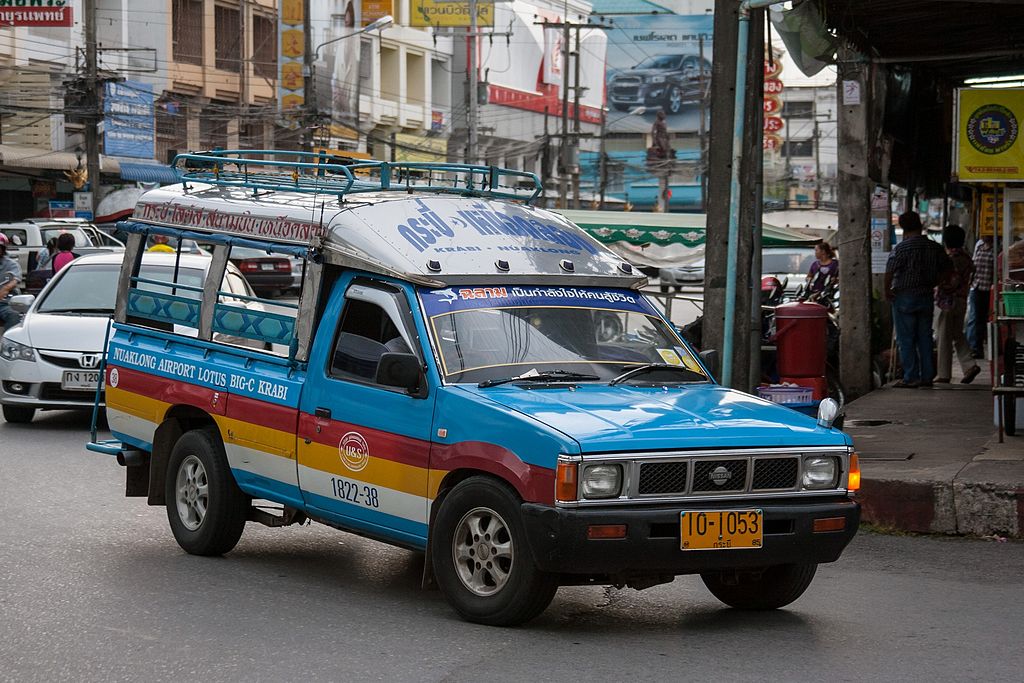
Another common form of transport used all over Thailand are songthaews. These are pickup trucks that have been converted to include long benches and can seat as many as eight passengers at a time. They typically follow certain routes and will agree to drive passengers headed the same way.
A songthaews is usually colour-coded, and each colour corresponds with a specific route that the songthaew takes.
For example, in Chiang Rai, light-blue songthaews are clearly marked ‘White Temple’. So they depart at the famous Golden Clock Tower in Chiang Rai city centre and take passengers to Wat Rong Khun- nicknamed White Temple because the entire temple is a striking and sparkling white colour. Chiang Rai’s Clock Tower is a trendy tourist destination, so taking this songthaew would be like killing two birds with one stone.
Other colours of songthaew may travel to different areas, so be sure to double-check where they are going before getting on. Songthaews can often be seen in the street but can also be found at a bus terminal, bus station, or a popular tourist attraction.
Generally, songthaew fare prices start at around 20 Thai Baht per person but depend on the length of the journey and can go as high as 300 THB.
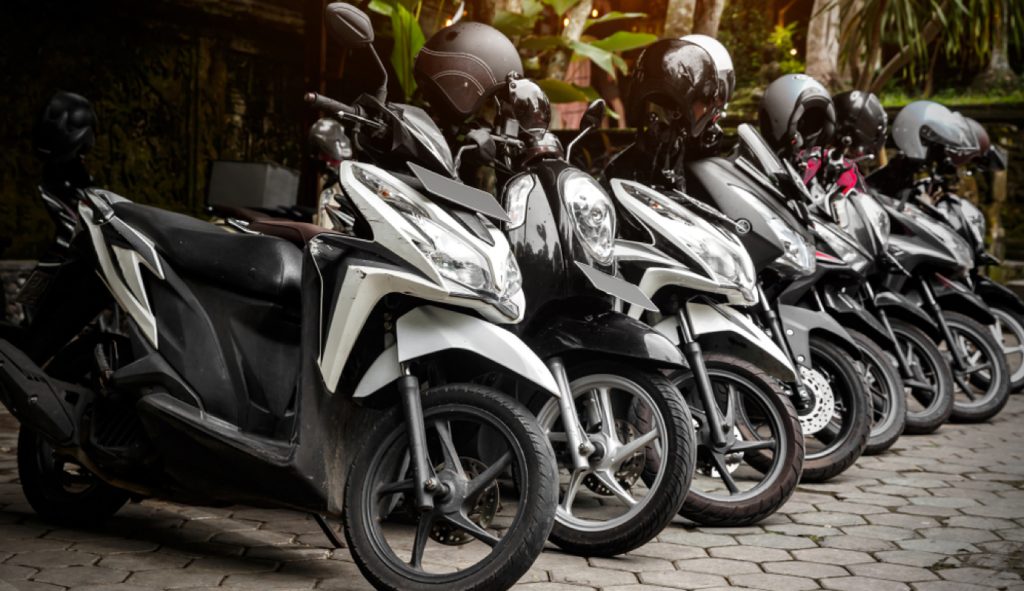
Renting a bicycle is an excellent option for outdoorsy tourists who like fresh air and exercise, and enjoy Chiang Rai’s countryside and gorgeous hills. They could even be used for day trips to the Hill Tribe villages found in Chiang Rai.
Bicycle rentals are also a good option for people taking shorter trips or leisurely drives and not venturing too far outside the city. Similarly, there are a few places in Chiang Rai where visitors can rent motorcycles.
Generally, motorcycle rentals in Thailand require a deposit of anything from 1000 to 5000 Thai Baht, depending on where you rent it. This can be paid either in cash or through electronic transfer. Visitors will get their deposit back once the motorbike is returned. However, while some rental services will accept a passport, license, or ID as a deposit when you don’t have the money, this is not recommended. Ensure you plan ahead and bring enough money with you if you intend to rent a motorcycle.
Note: When renting motorcycles, helmets are required. For both bicycle and motorcycle rentals, ensure you agree on a price before starting your day trip so that you are not charged a large sum at the end of the day.
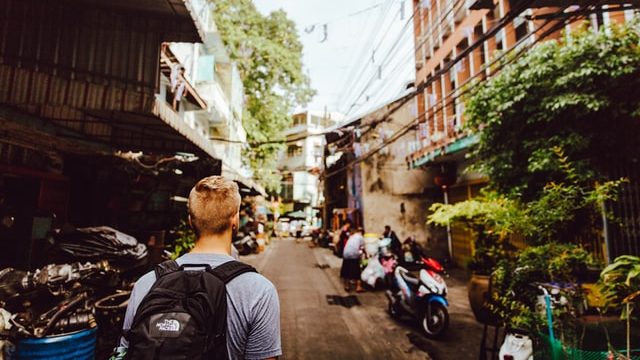
Because it is such a small city, many of the attractions in Chiang Rai are within walking distance, making it very pedestrian-friendly. For example, if you stay in Chiang Rai city centre, you could easily visit the Golden Clock Tower, the Night Bazaar, Wat Phra Sing, and the Chiang Rai Flower Fair on foot in one day.
Despite being such a small city, Chiang Rai has a lot to offer tourists travelling in the north of Thailand.
Chiang Rai province in northern Thailand is the neighbour of Chiang Mai province, which means that tourists who have their own car could easily enjoy day trips between the two. In fact, Chiang Rai city has been described as a small, sleepy version of Chiang Mai.
At the edge of Chiang Rai, Thailand meets Myanmar and Laos, and this connection is famously referred to as the Golden Triangle.
Chiang Rai also has many stunning Buddhist Temples, some of which are the most popular tourist attractions in Chiang Rai, like the White Temple Wat Rong Khun. For nature enthusiasts, Chiang Rai has beautiful landscapes, many waterfalls, and hot springs to visit. Furthermore, Chiang Rai has some interesting museums about the culture and history of the area, such as the Baan Dam Museum (Black House), the Oub Kham Museum, and the Hilltribe Museum.
When considering where to stay in Chiang Rai, you may choose to stay in more central locations, such as Chiang Rai city centre or clock tower, which are better for shopping, restaurants, or banks. However, you may choose to live outside the city, which would suit tourists who intend on travelling further or prefer being away from the hustle and bustle.
Regardless of your preferences, Chiang Rai is bound to have an ideal area for you.
Jump to location

Staying near the Golden Clock Tower and Night Market is an excellent option for tourists visiting Chiang Rai city for the first time. It has become a kind of hub for tourists, with many hotels, cafés, and restaurants.
This area also has accommodation options of all price ranges, making it perfect for tourists who have a low to mid-range budget. It will not be difficult to find a suitable hotel building or hostel in this area.
If you are travelling on your own and would like to meet like-minded people, this area is a perfect choice. It is also an excellent place for young people.
Because this is such a central area, most other parts of the city are within walking distance, which means you will rarely need a taxi or other form of transport. For example, you could easily walk to the Kok River area or explore the stalls at the Night Bazaar, Day Market, and Saturday Walking Street. This is an excellent area for shopping.
Another plus is that this location is close enough to walk to Wat Phra Kaew, the Temple of The Emerald Buddha, and is close to Chiang Rai International Airport.
Because this is a central area, most of the city’s hustle and bustle is found here. It can get quite busy with local Thai residents or tourists. It could get busy and noisy and wouldn’t be a good place for guests who prefer peace and quiet.

The Mae Kok River is a 285-kilometre long river in Chiang Rai that connects to the even larger Mekong River. Some of the best hotels in Chiang Rai can be found in this area, and the river Kok creates some stunning views. Both east and west of the Riverside Area, tourists will find beautiful hills and countryside, which is perfect for hiking and bicycle enthusiasts who like the fresh air.
This area is ideal for travellers with a larger budget. It would be easy to find a five-star hotel or some boutique resorts here. If you are looking for hotels that would include things like a swimming pool, fitness center, buffet food, and modern rooms and facilities, this is the area for you.
Another perk of the Riverside area is peace and relaxation. It is located far enough from the bustling city centre that noise isn’t a problem. However, it is still close to many of the Buddhist temples.
The area is more spacious and would be most convenient for family vacationers.
Because this area is so luxurious, the accommodation prices are much higher than in the city. Therefore, this would not be the best place for budget-conscious tourists.
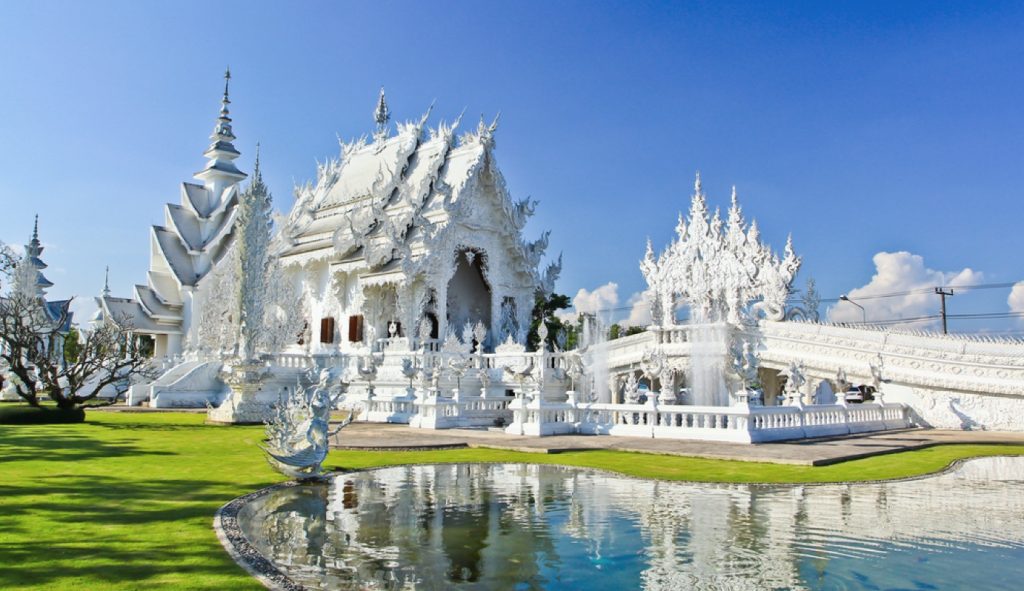
Wat Rong Khun is one of the most famous Buddhist Temples in Chiang Rai. Wat Rong Khun gained its nickname (White Temple) for the characteristic white plaster and sparkling glass used to build the entire temple. Some tourists have also described it as an elephant graveyard due to the bone-like colour and the elephant tusk sculptures adorning the walk up to the temple.
Similar to the Riverside region, the area surrounding the White Temple is ideal for tourists or families who prefer quiet and have a larger budget.
The White Temple is also close to Singha Park. Singha Park is owned by the company that produces Singha Beer and is a family-friendly tourist attraction in the Chiang Rai countryside. The park has large farmland areas with beautiful meadows, tea plantations that produce oolong tea, fruit orchards and barley fields that have been used to make Singha beer, malt drinks and other health foods. Visitors can take tours to see how tea is grown and produced.
Much like the Riverside area, the area surrounding the White Temple and Singha Park is more expensive. It has limited hotels and hostels, is located far from the city centre, and is not ideal for young tourists who enjoy the nightlife.
There is a wide variety of things to do when you visit Chiang Rai City. It has been described as a quirky and artistic city full of hidden gems.
Many people visit Chiang Rai as a day trip while staying in other northern Thailand cities, like Chiang Mai. However, Chiang Rai has much to offer visitors staying in the city for a few days. While not as big a city as Chiang Mai or Bangkok, Chiang Rai has many similar attractions- such as beautiful temples, fascinating cultural museums, and a Night Bazaar.
Discover some popular tourist activities to add to your own Chiang Rai itinerary.
Chiang Rai has some of the most famous Buddhist temples in Thailand, and they are all popular tourist attractions. For someone interested in Thai history and culture, these may be the perfect attractions to visit.
Perhaps the most popular is the famous White Temple or Wat Rong Khun. This striking temple was designed by the same artists who designed Chiang Rai’s famous Golden Clock Tower. To visit the White Temple, tourists will have to pay an entrance fee of around fifty Thai Baht. Also, note that the temple grounds can become crowded with other tourists. However, this isn’t the only remarkable Buddhist temple in Chiang Rai, Thailand.
Another beautiful white temple can be found at Wat Huay Pla Kang. The fascinating temple grounds are on top of a mountain, and the structures contain many different building styles.
Chiang Rai is also home to the Blue Temple, Wat Rong Suea Ten. This temple is striking because the entire temple is a vivid blue and gold colour and is truly a sight to behold. Many visitors have described it as nothing short of an art museum.
Chiang Rai’s famous Wat Phra Kaew is another must-see to put on your itinerary when visiting Chiang Rai. This temple is where the Emerald Buddha was originally found and is one of Thailand’s most sacred Buddhist Temples.
Other temples worth seeing include the Baan Dam Museum, which is often referred to as the Black House or Black Temple, even though it isn’t really a temple at all. This museum differs from the traditional Buddhist Temples in Chiang Rai because of its eclectic design that mixes traditional and modern elements. The museum was also used as an art studio and home for the Thai artist and creator of the building, Thawan Duchanee until he passed away in 2014.
Keep in mind that you will be expected to dress appropriately when visiting a temple in Chiang Rai. A good rule of thumb is to make sure your shoulders and knees are covered and ask whether you need to remove your shoes before entering.
Thai cuisine is some of the most delicious food in the world.
While Chiang Rai’s town centre, with its striking Golden Clock Tower, is already a popular attraction, many tourists explore Chiang Rai solely for the street food sold at food stalls throughout the city.
A great place to find some authentic Thai food is at the Chiang Rai Night Market or Night Bazaar in the city centre. It is close to the clock tower and Chiang Rai International Airport and the area is usually bustling with local residents and tourists. The market is ideal for shopping, and Thai food sold at food stalls or in a food court is usually much more affordable than in restaurants.
Any visit to Thailand would be incomplete without eating some Khao Soi.
The mountainous Chiang Rai province is home to many different indigenous hill tribes and their villages. One such tribe is the famous “long neck” Karen hill tribe, where the women may be seen wearing brass rings around their necks to give them their characteristic appearance.
This is an excellent way to truly immerse yourself in Chiang Rai’s rich culture and to see some more of the beautiful scenery Chiang Rai is famous for.
However, be aware that some visits to these hill tribe villages can be exploitive. Book your visit through a reputable agency and make sure that the visit you are planning is both ethical and welcomed by the village.
Chiang Rai also has a Hill Tribe Museum for tourists to learn more about each of the tribes’ individual customs and culture.
One of the most popular tourist attractions, especially for families, is Singha Park.
Singha Park is situated in Chiang Rai’s beautiful countryside, about six kilometres from the White Temple, and contains tea plantations famous for brewing oolong tea. In addition, every year, Singha park is responsible for arranging the hot air balloon festival. There is a myriad of activities for tourists to do on a day tour here, and Singha Park is free to enter.
Another popular plantation is the Choui Fong Tea Plantation.
This plantation is family-owned and prides itself on being a sustainable business that conserves resources and gives back to the community. The plantation is about an hour outside the city centre, and the drive is beautiful. It is open from around nine o’clock in the morning to five o’clock in the afternoons, and entry is free.
Chiang Rai is about 190 kilometres from Chiang Mai, which means that driving by car between the two will take around three hours.
Chiang Rai is about 790 kilometres from Bangkok.
Chiang Rai is a small city, so nearly everything is within walking distance.
The clock tower in Chiang Rai’s city centre is about 10 kilometres away from the International Airport, which means that it shouldn’t take more than twenty minutes by car from one to the other.
Generally, food from food stalls at the market or in a food court will cost less than restaurants. Therefore, it is a good idea to budget around 200 to 300 Thai Baht per day for food.
Chiang Rai city, as well as the surrounding mountains and province, has much to see and experience.
Most seasoned travellers agree that spending about three days in Chiang Rai should be enough time to see all the tourist attractions. However, if you are venturing far outside Chiang Rai City Centre, like a day trip to a tea plantation, for example, you may need to visit Chiang Rai for at least a week.
There are no beaches in Chiang Rai. However, there are still many water-based attractions. Chiang Rai has a variety of waterfalls and hot springs to enjoy and the famous Kok river.
Tourists especially enjoy visiting these sites during the hotter seasons.
As with many Night Bazaar or Night Market areas, the Chiang Rai Night Market can be a bit of a hotspot for thieves or pickpockets.
A good tip is to carry all your valuables, such as money, cellphones, documents, and keys, in a cross-body bag or waist pack. Avoid things that can easily be opened or snatched, like handbags or backpacks with zippers.
Chiang Rai’s iconic Golden Clock Tower makes for some beautiful photographs and is a popular selfie destination. However, keep in mind that it is in a busy area, so you will need to be careful. It also looks beautiful when lit up at night.
All of Thailand uses GMT + 7.
Chiang Rai is known as Thailand’s Agricultural Centre. It is famous for its beautiful natural scenery, green hills, and countryside filled with tea plantations, fields, hills, and farmlands.
Chiang Rai is also famously the area where Thailand meets the Laos and Myanmar border, called the Golden Triangle.